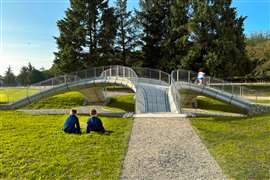Read this article in Français Deutsch Italiano Português Español
Holcim’s Phoenix bridge paves the way for more sustainable concrete construction
14 December 2023
Building materials company Holcim has unveiled Phoenix, the world’s first 3D-printed concrete masonry bridge.
 Holcim’s completed Phoenix bridge in Lyon, France. Photo: Block Research Group
Holcim’s completed Phoenix bridge in Lyon, France. Photo: Block Research Group
The infrastructure project, located at Holcim’s Innovation Hub in Lyon, France, was designed in collaboration with Block Research Group at ETH Zurich, Zaha Hadid Architects and Incremental3D and constructed using 10 tonnes of recycled materials.
Using its ECOCycle circular technology, Holcim developed a concrete ink, incorporating the recycled materials, to showcase the potential of circular construction, coupled with advanced computational design and 3D printing.
On the Phoenix bridge, the company said it had achieved a reduction of up to 50% in materials, without compromising performance.
The structure is designed to stand solely through compression, eliminating the need for traditional reinforcement.
Holcim said the modular blocks that make up the bridge can also be easily disassembled, making the bridge both adaptable and recyclable.
The next step for Holcim and its collaborative partners will be to explore possibilities for scaling up the process to provide broader and more generalised sustainable infrastructure solutions.
Collaborative design
 3D printing of the Phoenix bridge’s masonry. Photo: Incremental3D
3D printing of the Phoenix bridge’s masonry. Photo: Incremental3D
Philippe Block, co-director, Block Research Group at ETH Zurich, said, “Concrete is an artificial stone, and like stone, it does not want to be a straight beam, it wants to be a masonry arch. Following these historical principles allows us to keep materials separated for easy recycling and to dry-assemble the structure for easy deconstruction and reuse.
“3D concrete printing allows us to use material only and exactly where needed. The result is a sustainable and truly circular approach to concrete construction.”
Edelio Bermejo, head of global R&D at Holcim, said his company’s collaboration on the Phoenix project demonstrated that “…essential infrastructure can be designed and built in a way that is circular and low-carbon today”.
“This project,” he said, “showcases the impact that innovation can have in Holcim’s mission to decarbonise building for a net-zero future.”
STAY CONNECTED


Receive the information you need when you need it through our world-leading magazines, newsletters and daily briefings.
CONNECT WITH THE TEAM











